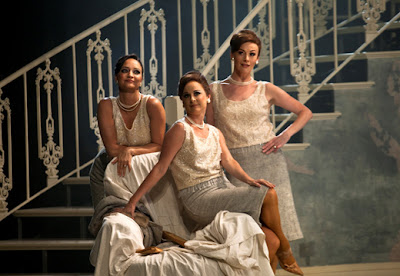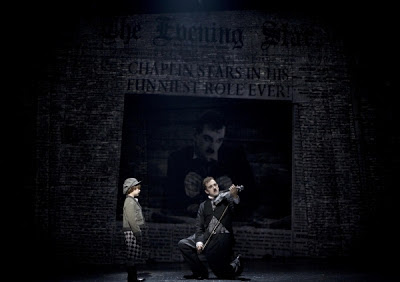I've always been a fan of Cirque du Soleil since seeing my first Cirque show with
Varekai, but usually I only get to see a Cirque show once a year or two. But life's been good to me this year, and I happened to get a chance to see 6 Cirque shows this year in a sort of Cirque craze marathon (out of 12 that I've seen, so half of the Cirque shows I've seen, I've seen this year!)! I got to go to Vegas a couple of times this year, and finally getting to see the much talked about
O,
The Beatles LOVE, the first Cirque sit down
Mystère, and
KÀ (
reviewed here). I also finally checked out
Zarkana in NYC, just before it closed to reopen soon in Vegas, joining the plethora of Cirque shows already there.
I also checked out Cirque's newest show
Amaluna in their traditional big yellow and blue touring tent Le Grand Chapiteau when it first opened in Montreal earlier this spring (
original review here). While I thought it was a nearly perfect Cirque show even as a new show in its preview stages, Cirque will often tinker with its shows until it is just right, even after Opening Night. I was curious to see if any changes were made as it travelled to Toronto.
Well, to be honest, my memory for detail isn't strong enough to determine if many changes were made to
Amaluna, but I can say what was a nearly perfect show, now feels like an even tighter, more cohesive Cirque show that easily joins the best Cirque du Soleil shows (which, like Pixar films, have such a high standard, that even when they're not the best Cirque show, they are still generally better than most shows out there, and I probably tend to grade Cirque shows more harshly against each other).
Amaluna has easily become one of my top 3 Cirque shows in the Montreal company's canon.
Amaluna, directed by Broadway director Diane Paulus (
Hair, The Gershwins' Porgy and Bess), is the first Cirque show to use a template story, Shakespeare's
The Tempest with a touch of
Romeo and Juliet, and is also the first Cirque show to be dominated by a female cast and band, with the show as a celebration of woman (and a cast comprised of about 70% women). From Marie Michelle Faber as the moon (who does tricks on a flying hoop WHILE singing), to Lara Jacobs the balance goddess, who even upon second viewing, is absolutely mesmerizing as she creates a giant mobile, a description that doesn't even come close to describing the intensity, the silence, and the awe the act inspires.

Prospera conjures up a storm (with an aerial act) that brings a bunch of shipwrecked sailers to this island of women, including a handsome man, Romeo, for Prospera's daughter Miranda to flirt with. Iuliia Mykhailova and Edouard Doye gives us a Miranda and Romeo romance to root for, as different circus acts add to the plot and keep the lovebirds apart, lead by Cali, Miranda's pet lizard. Other obstacles include some warrior women on low bars, the shirtless sailers on a seesaw plank, and a highwire act up in the clouds as Miranda gets flown away from her Romeo.
The story helps add a narrative cohesion to the show (also used well in
OVO (
my review), the only other Cirque show directed by a woman, and
KÀ) that adds an extra layer to the showmanship package Cirque is famous for. I had minor quibbles about the clowns and one dance act by a woman in white in the Montreal incarnation but they seemed to blend in far better this time around. The integration of all the characters into each act and blending into one another also helps with the flow of the show and keeps
Amaluna feeling like one entity (as opposed to a series of circus acts, which Cirque is essentially is).
It's also impressive when you see the characters you're getting emotionally attached to, start performing an impressive trick, becoming the next act. Mykhailova isn't just our endearing Miranda, but does a beautiful balance and contortion act in and around a water bowl, while Doye shows us his insanely impressive abs and puts them to use as he climbs a pole (trying to rescue Miranda in the sky) with his bare hands (with no help from his feet, as he's turned to the side, or in many other angular variations).
The second viewing also gave me a better chance to notice details I had missed in my first awe-inducing viewing, thus inspiring even further awe. The ladies in the highwire act were walking the wire either on-point, or in high heels. The intensity in the production and sound design (that Globe and Mail's
Nestruck first noted) that surrounds the slow-build intensity of Jacobs' balancing act. The amount and types of rotations the Chinese tumblers perform (while swinging lighted orbs). There isn't one circus act here that isn't impressive, including a juggling act that takes juggling and manipulation to another level, but Paulus and the creative team have chiseled away a beautifully smooth and sensuous show that shows the strong, yet soft side of women.
Zarkana first opened at the grand Radio City Music Hall, a beautiful venue in itself, but Zarkana creates some epic imagery, but the dark imagery at that. With giant projections of giant eyeballs, a creepy baby (called the pickled lady), and enormous snakes, it was probably a little too dark for the family-friendly audience it was hoping to attract in New York, but may fit in better in Las Vegas. While the sort of Frankenstein etches an outline for the acts, some of the acts, while impressive, seemed a little small for the giant Radio City Music Hall stage.

They bring out the Wheel of Death, but there's also a single ball bouncer/juggler. Both impressive acts, but only one fills the enormous frame of Radio City's stage. It's only until near the end, do the final two acts seem mindblowing, when the flying trapeze, and a banquine (think super cheerleading gymnastics) acts actually inspire gasps. Still, the simpler acts are quite beautiful, including a sand painting act (!?!) and a handbalancing act, but it's hard to admire the chiseled muscle on the handbalancer when you're sitting in such a large venue.
The flying trapeze comes about when a giant spider web envelops the stage (looking like what
Spider-Man: Turn Off the Dark probably wanted to be), and truly utilizes the height and space of the venue, but the thematic elements of the show seem like a hodgepodge of horror house ideas. Still, when those trapeze artists are flying through the air, or the banquine performers are flipping over and on top of each other in multiple unison, it's hard to begrudge the show when there is such cool stuff on stage.
The Beatles LOVE is the first show to utilize existing music (since Cirque is usually famous for it's own scores), in a collaborative tribute to The Beatles, using new versions of the band's famous songs specifically created for the show. The joys of The Beatles music comes to life visually in what becomes more of a dance theatre piece than a typical Cirque show. The story of The Beatles, from children during the war, is sketchily outlined with their music, and movement and circus acrobatics help enhance their music, as opposed to music and a theme tying together different circus acts. Every song now becomes a beautiful image, with silhouettes of The Beatles appearing on screens every once in a while, and it becomes Cirque du Soleil's visual poetic ode to one of the most famed bands ever.
In a specially designed theatre at The Mirage, the 360 in-the-round (sort of) stage is filled with so many dancers and acrobatics that it's often difficult to know where to focus on, with many little moments are happening everywhere on stage at the same time. The show is at its best when there is a particular focus, like in the telephone booth scene (a jumping/trampoline act), or at the fair with the roller skaters, in the most Cirque-like moments.


















































